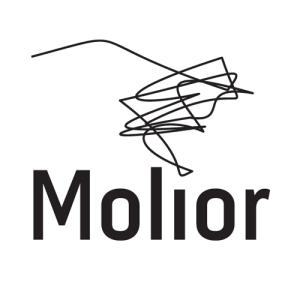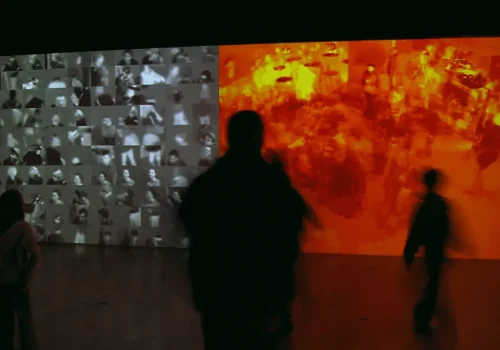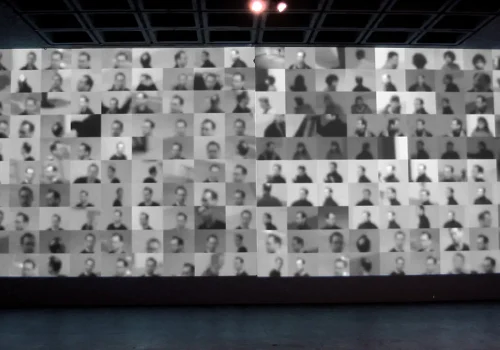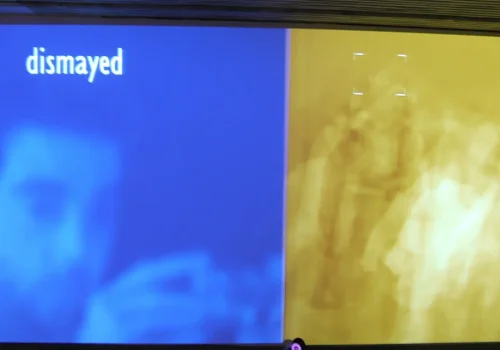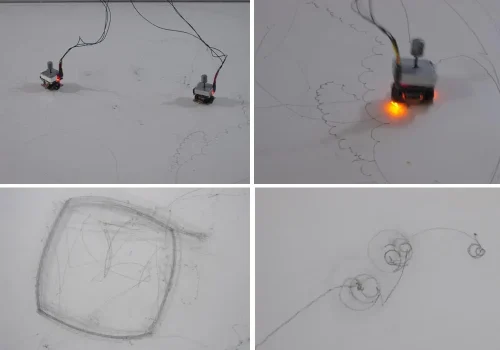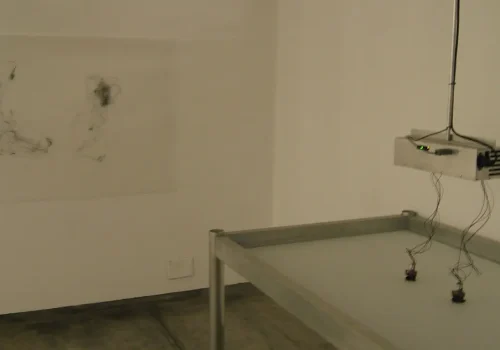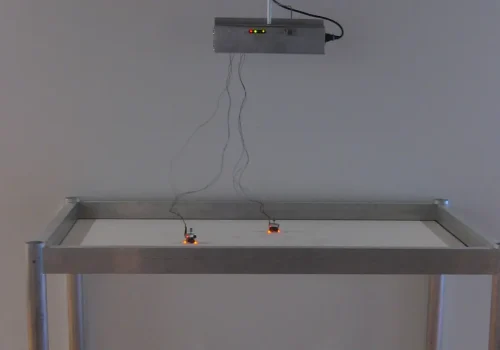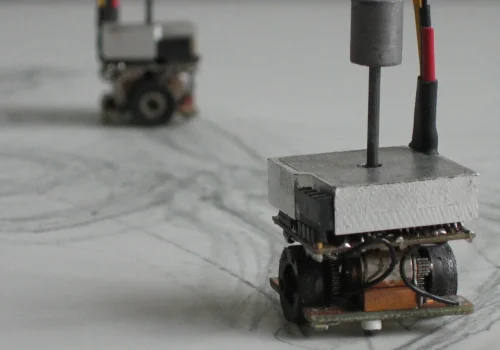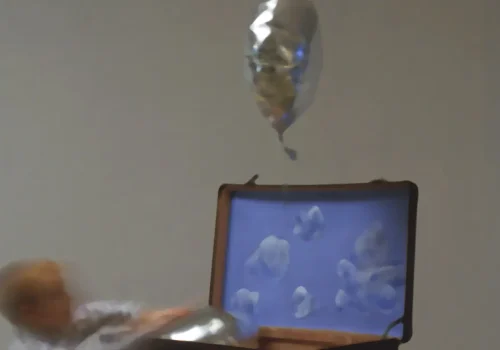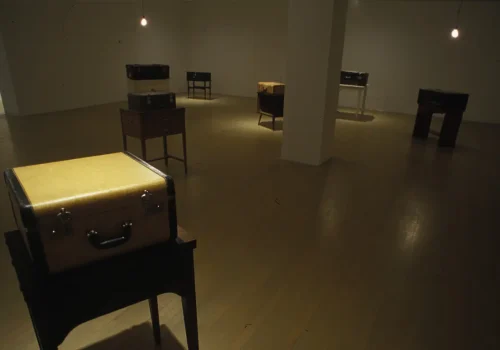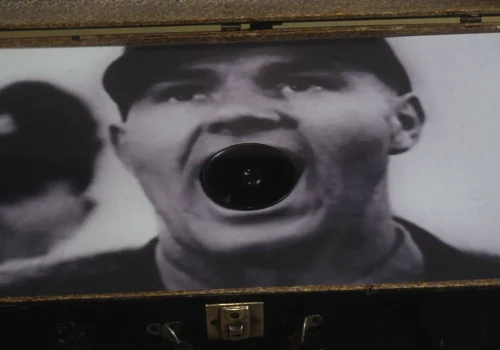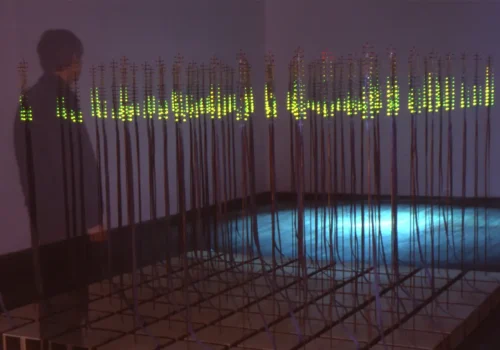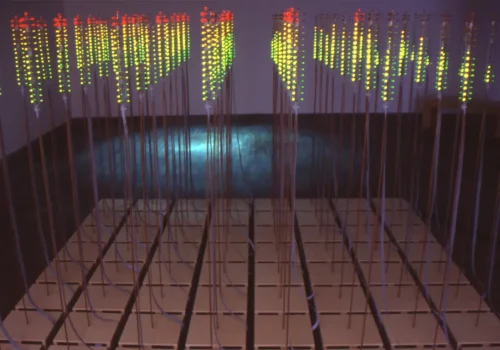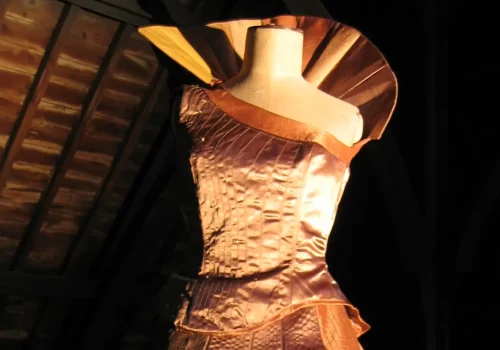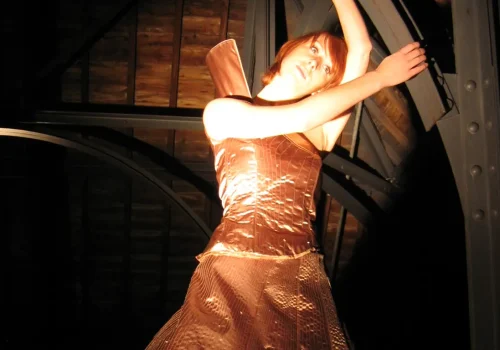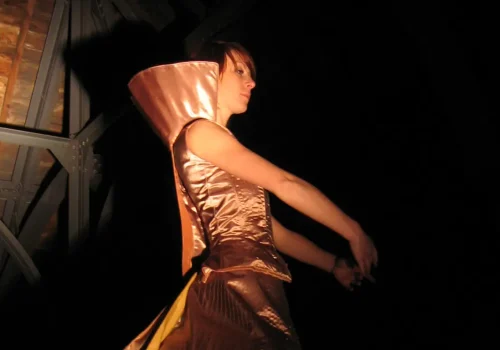Transitions/Transiciones
Centro Cultural de la Pontificia Universidad Católica del Perú (PUCP), Lima, Peru
From April 11th to May 11th, 2007
Curator
Renee Baert
Artists
Transitions considers the layering of spatial, temporal and conceptual dimensions in the interactive work of five Canadian artists. These multiple registers are in many instances produced through technological achievement in new media at an advanced level of innovation. The transitions the works enact from one condition or state or place or time or action to another are integral to each specific investigation. Through these, the artists create objects and situations that open up to cultural questions that are equally layered, and rich with meaning and implication.
In this exhibition, Ingrid Bachmann presents a gathering of suitcases, each of which open to their singular, animate narrative (The Portable Sublime); Steve Heimbecker presents a visual analogue of the wave patterns of the wind (POD); Valérie Lamontagne utilizes technological interfaces to activate dresses inspired by a fairy tale (Peau d’Âne); Éric Raymond enables fictional cartographies to be drawn by miniature robots (Scribes) and David Rokeby creates a surveillance environment that tracks visitors within the gallery space (Taken).
One aspect of the Transitions of the title is the transit the works enact between different spaces and geographies. Suitcases, as such, convey this reference to mobility and transposition. In other works, the spatial transpositions are produced through technological application and innovation: a prairie wheatfield is metaphorically sited in a Peru gallery; imaginary cartographies are derived from real geographies; the spectatorial body is transposed from its three-dimensional stance in the gallery to a fading projection on its walls.
In several works, however, that which passes from one state to another is more intangible – an element invisible to the eye in its natural state yet ‘located’ through the works: the registration of the windscape of a Montreal rooftop; the material rendering of sunlight and moonbeam; cartographies derived from extracted electromagnetic waves.
Temporalities also undergo transitions and transfers. Many of the works utilize recording or capturing mechanisms (video, computers, sensors, interfaces) as structuring elements. In Rokeby’s Taken, actions originating in ‘live’ time are looped, layered, reiterated, then allowed to fade away; Heimbecker’s POD transposes the windscape of an ephemeral autumnal night in 2005 to a lively rendering in the present; Bachmann treats as contemporaneous new technologies and the tools of previous eras, while in Lamontagne’s Peau d’Âne, a challenge set in a 17th C fable is met – perhaps surpassed – in the present.
The exhibition title might also suggest conceptual shifts. Bachmann’s several suitcases do not carry a traveller’s belongings to another place; rather, when opened, they reveal that they are each, differently, the ‘place’ of an imagined world; the visitor in Rokeby’s installation may fluctuate wildly between responses of attraction and recoil, incompatibilities each grounded in its own perceptual entirety, while Heimbecker’s installation operates through several conceptual relays.
The works are interactive in myriad ways, whether responding to a natural environment (POD, Peau d’Âne) or audience activated (The Portable Sublime, Taken). A performative element is frequently at play: the Sun Dress and Moon Dress of Peau d’Âne, presented freestanding, can also be worn; the suitcases are activated when opened, then close to their mysteries again; the actions of the audience create the conditions of action of Taken; the robots animate the cartographic drawings of Scribes.
A cartographic subtext reinforces the sense of geographies and locales that are transposed in these works: natural emissions in the immediate environment are eventually transposed into a cartographic registration by robots; dresses provide a type of ‘weather’ mapping while bringing a skyscape into the gallery, Heimbecker ‘scores’ the wind.
The works in Transitions transform everyday familiarities – wind and sky and sound and movement and myriad things of our object world – into portals for unpredictable perceptions and experiences.
Renee Baert
Renee Baert
Renee Baert has worked in the area of contemporary visual art as a critic, curator, editor and teacher for some 20 years. New media art practices have been an important part of her research, from her writings on video art in the early l980s to her recent exhibition and catalogue on the robotic interactive work of Max Dean (Ottawa Art Gallery). She was Director/Curator of the Gallery at the Saidye Bronfman Centre for the Arts.
Artists & works
David Rokeby
Taken
2002
Interactive installation
Description of the work
Taken is a surveillance installation that provides two readings of the activities in the gallery space. A large gallery space has one wall taken up by two very large projections. On the left hand side, gallery visitors are extracted from the ground of the gallery floors and walls, and then looped back onto themselves at 20 seconds intervals. The result is that every action that has taken place in the gallery since the computer was turned on occurs together on the screen, repeating every 20 seconds. The image stream provides a kind of seething chaos of activity that can be read both as a statistical plot of gallery activities (where do most people stand to regard the piece? Do they move around?) and as a record of each act of each visitor. The image is densely social, deeply layered and chaotic. The right hand side is a cooler catalogue of the gallery visitors. Individual visitors are tracked within the space. Their heads are zoomed in on, and adjectives are attributed to them (i.e. ‘unsuspecting’, ‘complicit’, ‘hungry’). These individual head shots are collected as a set of the last 200 visitors and presented as a matrix of 100 or occasionally all 200 shots, moving in slow motion. This side is analytical and highly ordered and rather threatening.
Biography
David Rokeby creates interactive installations that react to the presence of the viewer or explore the potential of the database. His works also comprise interfaces that make it possible to capture and transform the movement of individuals into sounds and images.
He regularly exhibits in Canada, the US, Europe and Asia, notably at the Beall Centre For Art + Technology (Irvine, California) in 2015, at Fresnoy studio national des arts contemporains (Tourcoing, France) in 2012, and the Whitney Museum of American Art (New York). He has participated in international events, such as Electrohype 2010 (Ystads, Sweden) and Mois de la photo à Montréal (2009), Transmediale Festival (Berlin, Allemagne) and the São Paulo Biennale in 2007. Molior presented his works in Transitions / Transiciones, at the Centro Cultural de la Pontificia Universidad Católica del Perú (PUCP) in 2007, and again at SYNTHETIC TIMES – Media Art China 2008 at the National Art Museum of China (NAMOC), Beijing.
In 1988, he received the Petro-Canada award for media arts, the Ars Electronica Award of Distinction for Interactive Art (Austria) in 1991, in 1997 (jointly with Paul Garrin), and again in 2002, the same year that he received the Governor General’s Award for Visual and Media Arts.
The Montreal Museum of Fine Arts, the National Gallery of Canada, the Fondation Daniel Langlois and the Agnes Etherington Art Center have acquired his works. David Rokeby has also created several public art works.
Éric Raymond
Scribes
2005
Installation
Description of the work
Scribes is a media art installation using miniatures robots and radio waves to draw cartographic images derived from multiple emitting sources. Satellite images and natural electromagnetic interferences are merged together to create a new representation of surrounding phenomenons. The resulting map gives a complex layered image of both natural and artificial radio events reaching beyond perceptual threshold. It creates a very suggestive environment where language and data shifts are exploited for their metaphoric potential.
Biography
Éric Raymond has been active in the field of electronic arts for over ten years. He has exhibited his work on the national and international scene notably at the Absolut L.A. International Biennial Art Invitational (L.A., U.S.A.), Ars Electronica (Linz, Austria), L.A.Freewave (L.A. U.S.A.), Artcore Gallery (Toronto) and Dazibao (Montréal). He has published papers in Parachute Contemporary Art, Archée and HorizonZero. He teaches at the Visual and Media Arts School (École des arts visuels et médiatiques) at the Université du Québec à Montréal.
Ingrid Bachmann
The Portable Sublime
2003
Installation
Description of the work
Assorted suitcases, switches, light sensors, mechanical boats, speakers, water, water pump, two CD players, speakers, amplifiers, balloons, glass, metal, assorted material.
This very material and somewhat practical exhibition explores the possibilities of containing the sublime in a more manageable form. The sublime often invokes the grand, the ethereal, and generally involves leaving the cares of the material world behind. Certainly, you rarely think of laundry and the sublime at the same time. Using prosaic materials, I want to create mobile spaces of provisional wonder.
Biography
Lives and works in Montreal
Ingrid Bachmann is known for her interactive installations that combine technology and everyday objects. Her multidisciplinary works draw on the textile, sculpture and kinetic art fields. Her use of technology seeks to demystify it and make it more human, by integrating a sensual and emotional dimension that counters the alienation that is often associated with the machine.
Her work has been exhibited in Quebec, Canada and abroad, notably in Europe on several occasions. She has also taken part in many international visual and digital arts events. Molior presented her work as part of Despertar / Éveil / Alive at Sesc Santana in Sao Paulo (Brazil) in 2014, Transitions / Transiciones, at Centro Cultural de la Pontificia Universidad Católica del Perú, Lima (Peru) and during B/R/T Le corps habité in Montreal, 2007.
An associate professor at Concordia University (Montreal), Ingrid Bachmann was a founding member of Hexagram, an interuniversity media arts research and creation centre. She is the director of the Institute of Everyday Life, a studio laboratory that examines everydayness. She has been a guest speaker at Goldsmiths College (London, UK), the University of Wollongong (Australia), the University of Maryland (Baltimore) and the Art Institute de Chicago.
Steve Heimbecker
POD
2003
Installation
Description ofthe work
POD (2003) is the first installation created for the Wind Array Cascade Machine (WACM) system. POD is a 64 channel installation that uses 2 880 light emitting diodes (LEDs) to portray a real time 4 dimensional picture of the wind, where each of 64 “pods”, functions as an amplitude meter of the 64 wind sensors of the WACM data network. POD will play from recorded wind data or when possible can play streamed live data from Montreal. POD was most recently exhibited at Gallery Oboro, Montreal, directly after it’s European premiere at the Museum of Contemporary Art Kiasma, Helsinki, Findland, for ISEA 2004.
Biography
Living in Montreal, QC, Canadian Steve Heimbecker studied fine art at The Alberta College of Art and Design in Calgary. For nearly 2 decades Heimbecker has made been recognized for his contributions in audio art installation, performance, and multi channel sound diffusion composition in Canada. Heimbecker’s installation, exhibitions and performances have been presented in Canada at such festivals as The Works, Send + Receive, Mois Multi, and Subtle Technologies, and such galleries as The Glenbow Museum, Illingworth Kerr Gallery, Avatar, and Oboro. In Europe, most recently in Finland, at the Kiasma Museum of Contempory Art – ISEA 2004 Wireless Exhibition, and in Austria at ORF Kunstradio & Ars Electronica Centre. He is currently working on two long term projects, the new media network installation series “Wind Array Cascade Machine” and the audio art DVD 5.1 surround sound publication and series “Songs of Place”.
Valérie Lamontagne
Peau d’âne
2005-2008
Installation
Description of the work
In the Charles Perrault fairy tale “Peau d’Âne” a young princess, whose kingdom’s riches are dependant on a gold excreting donkey, orders the impossible from her doting stepfather to thwart marrying him: three dresses made of immaterial materials. The first is to be made of the “sky” and should be as light and airy as the clouds. The second is to be made of “moonbeams” and should reflect the same lyrical intensity as the moon at night. The third, and last, is to be made of “sunlight” and should be as blinding and warm as the sun above.
This project is part of a body of research that focuses on relational and ubiquitous performance. Investigating historical performance-centric contexts and adapting new scenarios for wearable and sensing technologies, Peau d’Âne seeks to create a bridge between the symbolic percipience of fairy tales and current technological innovation. In particular, this project explores the potential for wearables to become agents of performativity.
Biography
Valérie Lamontagne is a Montréal-based performance and digital media artist, freelance art critic and independent curator. She received an MFA from Concordia University (Montréal) where she presently teaches in Design and Computation Arts and she is a co-founder, with Brad Todd, of the media arts collective MobileGaze. She is presently a Ph.D. Candidate investigating “Relational and Ubiquitous Performance Art” at Concordia University.
